Hyperconjugation
Hyperconjugation, as you point out, is able to stabilise carbocation intermediates, IUPAC define this as:
the interaction is ... between σ-bonds and an unfilled or partially filled π- or p-orbital
Ref: IUPAC Gold Book
In a simple sense, we can visualise this interaction by drawing the carbocation and considering the adjacent σ bonds able to interact.

This can also be visualised in a more 'quantitative' way by considering a simple mixing of orbitals, in which we can see that the σC-H -> p+ lowers the energy relative to the vacant p-orbital.

Ref: Molecular orbitals and organic chemical reactions, Fleming
Stability of carbocations
If we now consider the various types of cation, we should be able to rationalise the order of stability.

The methyl group is completely unstabilised through hyperconjugation, due to the stereoelectronic requirement that the σ bond be located on the adjacant carbon (of which the methyl cation has none).
Primary carbocations have a maximum of 3 σ-bonds capable of hyperconjugation, secondary a maximum of 6, tertiary a maximum of 9– hence why the tertiary is the most stable cation out of the simply alkyl groups (the allyl and benzyl systems in the diagram above are stabilised through delocalisation of the charge onto the pi system).
Going back to your question of ethyl vs propyl carbocations, you can hopefully now see that they have the same number of σ-bonds in the correct position to participate in hyperconjugation.
An additional complication
Primary carbocations are sufficiently unstable that if they form, they tend to rearrange into more stable carbocations, such that the primary propyl cation will quickly undergo a 1,2-hydride shift to give the secondary propyl cation. A more complex example is shown below:





